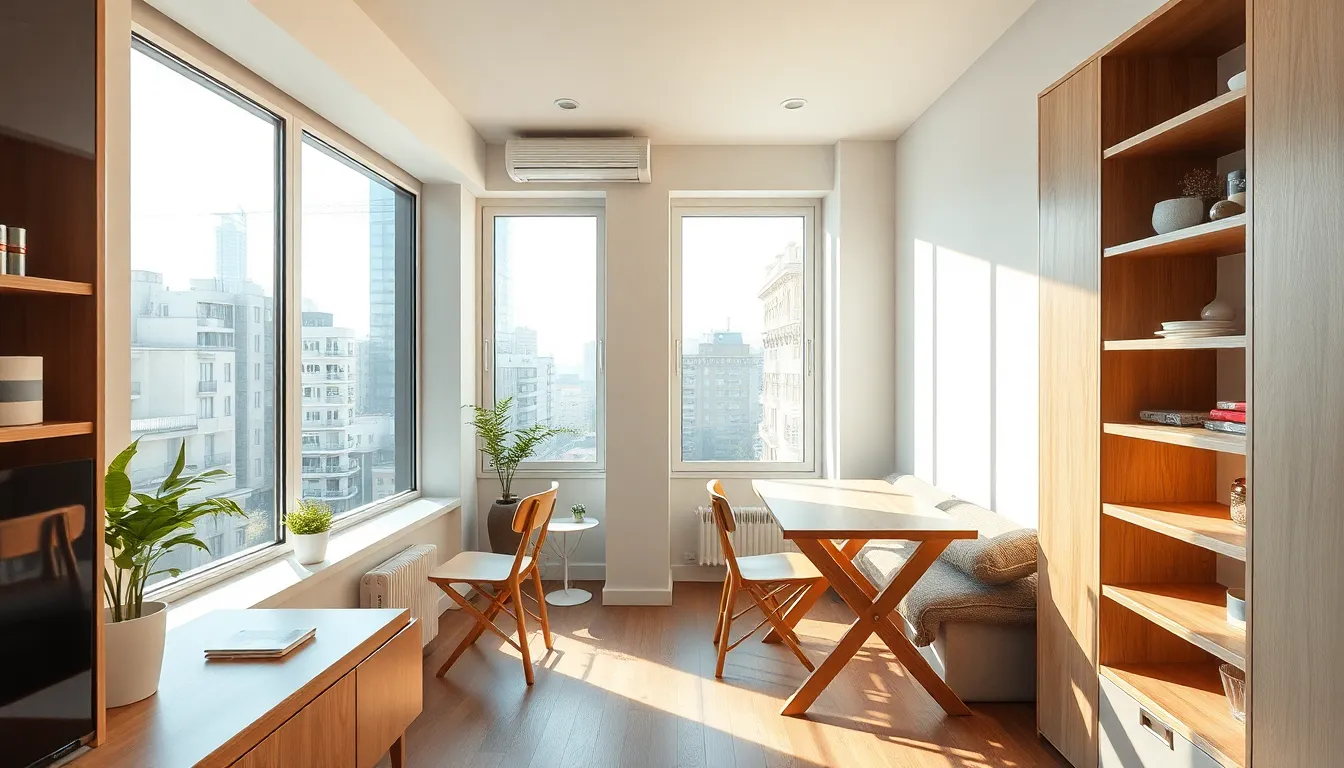As urban populations swell, finding affordable housing becomes a pressing challenge. Micro apartments have emerged as a creative solution, offering compact living spaces that maximize functionality without sacrificing style. These innovative dwellings cater to a growing demographic of city dwellers who prioritize convenience and efficiency over square footage.
Micro apartments not only provide a practical living arrangement but also promote a minimalist lifestyle. With smart design elements and multifunctional furniture, these spaces prove that less truly can be more. By exploring various micro apartment solutions, individuals can discover how to make the most of limited space while enjoying the benefits of urban living.
Table of Contents
ToggleOverview of Micro Apartments Solutions
Micro apartments embody innovative design, making efficient use of limited space in urban environments. These compact units, typically ranging from 200 to 600 square feet, provide essential living amenities while promoting a streamlined lifestyle.
Key Features of Micro Apartments
- Space Maximization: Creative layouts utilize vertical space with built-in shelving and lofted beds, allowing easier navigation and visual openness.
- Multifunctional Furniture: Furniture pieces, such as sofa beds and extendable tables, serve multiple purposes, enhancing usability of the living area.
- Smart Technology: Integrated smart home systems facilitate seamless control of lighting, heating, and security, elevating comfort and convenience.
- Sustainable Practices: Micro apartments often emphasize sustainability through energy-efficient appliances and eco-friendly building materials, addressing environmental concerns.
Benefits of Micro Apartments
- Affordability: Lower rent and utility costs make micro apartments a viable option for those seeking economical living solutions in high-demand areas.
- Location Advantage: Proximity to urban amenities such as transportation, dining, and entertainment facilities contributes to a lifestyle that values accessibility.
- Community Engagement: Many micro apartment complexes foster a sense of community through shared spaces, including lounges and co-working areas, encouraging social interaction.
- Minimalist Living: By promoting a decluttered lifestyle, micro apartments inspire residents to prioritize essentials and live more intentionally.
Examples of Micro Apartment Solutions
| Apartment Type | Description | Location | Price Range |
|---|---|---|---|
| Modular Micro Units | Prefabricated units designed for quick assembly | Urban centers | $1,000 – $2,000/month |
| Co-living Spaces | Shared living arrangements with private rooms | Major cities | $800 – $1,500/month |
| Converted Studios | Renovated warehouse or commercial buildings | Downtown areas | $1,200 – $3,000/month |
Micro apartments provide viable solutions to urban housing challenges, emphasizing adaptability and function for modern living.
Benefits of Micro Apartments

Micro apartments offer numerous advantages that appeal to urban dwellers. Their design prioritizes efficiency and sustainability, creating a unique living experience.
Space Efficiency
Space efficiency stands as a cornerstone of micro apartments. Compact layouts often maximize utility, allowing residents to optimize every square foot. Implementing multifunctional furniture, like sofa beds or foldable tables, expands usability. Clever storage solutions, such as built-in shelving and under-bed compartments, further enhance organization. By prioritizing vertical space with wall-integrated storage, these apartments create airy environments despite limited square footage.
Affordability
Affordability ranks as a significant benefit of micro apartments. With average costs often 30% lower than traditional apartments, they provide accessible living options in high-demand urban areas. Lower utility bills stem from reduced space needing climate control. Micro apartments also promote minimalism, leading to a lifestyle that discourages excess spending. Locations commonly near public transportation reduce commuting costs further, making urban living financially viable for individuals and small families.
Design Considerations
Designing micro apartments involves careful attention to functionality and efficiency. These compact spaces require innovative solutions to ensure that every square foot is used effectively.
Functional Furniture
Functional furniture plays a crucial role in micro apartment design. Furniture pieces should serve multiple purposes to maximize usability. Examples include:
- Sofa beds: Transform spaces from living areas to sleeping quarters.
- Expandable tables: Adapt to accommodate guests during meals.
- Storage ottomans: Combine seating with hidden storage.
- Foldable desks: Provide workspace that can be tucked away when not in use.
Choosing configurable and flexible furniture enhances the living experience, allowing residents to adapt their environments according to their needs.
Smart Storage Solutions
Smart storage solutions optimize space in micro apartments. Creative storage options can significantly improve functionality. Key strategies include:
- Built-in shelves: Create vertical storage that takes advantage of wall space.
- Under-bed storage: Utilize the area beneath beds for rarely used items.
- Nook storage: Design alcoves or corners to host small shelves or cabinets.
- Multifunctional closets: Incorporate organizers and compartments for efficiency.
Integrating these storage solutions allows residents to declutter their living areas, promoting a more streamlined and organized environment.
Popular Micro Apartments Solutions
Micro apartments utilize innovative approaches to create compact living spaces that suit urban lifestyles. Two popular solutions are pre-built units and custom designs, each offering unique advantages.
Pre-Built Units
Pre-built micro apartments provide efficient housing options that can be quickly deployed. These units often adhere to strict design standards, ensuring quality and functionality. Key benefits include:
- Rapid Implementation: Pre-built units can be installed within weeks, offering a fast solution to housing shortages.
- Standardized Features: These apartments typically include optimized space layouts, energy-efficient appliances, and stylish finishes.
- Cost-Effectiveness: Lower manufacturing costs often translate to more affordable housing options, making them attractive in high-demand areas.
- Environmental Sustainability: Many pre-built units integrate eco-friendly materials and construction methods, promoting sustainable living practices.
Custom Designs
Custom-designed micro apartments allow residents to tailor their living spaces according to personal preferences and needs. This solution emphasizes individual expression while maximizing utility. Key benefits include:
- Personalized Layouts: Owners can choose unique configurations and styles that enhance both comfort and functionality.
- Adaptability: Custom designs can incorporate specific features, such as built-in storage, foldable furniture, and smart technology.
- Increased Value: Well-designed custom units may offer higher property values due to their tailored nature and appeal to prospective buyers or renters.
- Creative Solutions: Homeowners engage with architects and designers to develop innovative ideas that meet bespoke needs, resulting in efficient and personalized spaces.
Through pre-built units and custom designs, micro apartments continue to adapt to the evolving demands of urban living, providing practical and stylish solutions to contemporary housing challenges.
Challenges and Limitations
Micro apartments face several challenges and limitations, particularly in urban environments where space and regulations intersect. Understanding these obstacles is crucial for evaluating the feasibility and sustainability of micro living.
Zoning Regulations
Zoning regulations often restrict the development of micro apartments in many urban areas. Local laws typically dictate minimum unit sizes, occupancy limits, and the types of structures permitted, which can inhibit the construction of compact living spaces. Some areas may not allow high-density developments, thereby limiting housing availability. Compliance with these regulations can increase costs and complicate the approval process for developers.
Space Constraints
Space constraints pose significant challenges in micro apartments. While these units maximize efficiencies, they often lack essential amenities found in larger residences, such as dedicated laundry rooms or extensive kitchen areas. Limited square footage can lead to feelings of confinement, particularly for individuals or families with numerous possessions. Efficient use of space becomes paramount, requiring careful planning and smart storage solutions to maintain livability and comfort.
Micro apartments represent a forward-thinking approach to urban living. They offer an attractive alternative for those seeking affordability and efficiency in crowded cities. By embracing smart design and multifunctional furniture, residents can enjoy a comfortable lifestyle without sacrificing style or convenience.
While challenges like zoning regulations and limited amenities exist, the benefits of micro apartments are undeniable. They foster a sense of community and encourage intentional living, making them an appealing choice for many. As urban areas continue to evolve, micro apartments will likely play a crucial role in addressing housing shortages and enhancing the quality of life for city dwellers.



